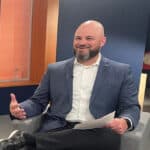The latest Goldman Sachs Retirement Survey & Insights Report, released Thursday, Sept. 26, underscores what most financial advisors already believe: Planning and advice is still the best way for employees to find the “financial grit” needed to build a successful retirement portfolio.
That stirring phrase came up several times in a recent Goldman Sachs webinar on the report.
“It’s clear that in the U.S., life happens. Life events and financial obstacles continue to disrupt retirement savings,” Greg Wilson, head of retirement in Goldman’s asset & wealth management division (AWM), said while moderating the webinar panel discussion. “Our survey shows that many workers are not adequately prepared.”
But with the support of financial planning, workers can overcome such challenges as student loans, credit card debt, costs of caregiving and escalating healthcare costs, the Goldman Sachs panel said.
These factors are often referred to as the “financial vortex” — a more chilling phrase describing what most workers face while trying to save for the future.
More Savings Satisfaction
Goldman’s survey included 4,874 respondents — 3,280 working and 1,594 retired individuals. Among the working respondents, those who create a financial plan are not only “more confident” about managing their savings, but save more for their retirement, said panelist Christopher Ceder, senior retirement strategist with Goldman Sachs Asset Management.
Retirees with a plan are “more likely to have consistent spending in their retirement. Frankly, they’re less likely to have to work part-time in retirement because they need to supplement their income,” Ceder said.
Providing additional insights were panelists Gregory Calnon, global co-head of public investing for Goldman Sachs Asset Management (GSAM) and Nancy R. DeRusso, head of Financial Planning, Financial Wellness and SurvivorSupport® for Goldman Sachs Ayco in Newport Beach, Calif.
401(k)s Don’t Come with Advice
401(k) and other retirement savings programs are widely available, Ceder said. But the “missing link” from most of these tools is the planning element.
“There are a whole lot of people who need advice but don’t get it,” he said.
The challenge, he added, is to make such services “broadly available.”
The Goldman Sachs survey showed that despite the increased participation in defined contribution plans, the bottom 80% of earners have seen more limited growth of their savings than the 20% of earners making $100,000 or more.
But despite differences in salaries, earners of all levels could still benefit from planning — both in terms of how they invest and how they address other financial insecurities such as debt, the panelists agreed.
Powerful Stats
This was illustrated in another statistic from the survey: 59% of retired respondents without a financial plan had less than $100,000 in retirement savings, but only 16% of those with a financial plan had that little in savings. However, 55% of retired respondents who had a financial plan had more than $500,000, while 21% of those without a financial plan had saved that much.
For working respondents, 80% of those with a financial plan were more likely to be on track or ahead of schedule with their savings, compared with 39% without a plan, the survey showed.
And financial planning is a factor employees can control in growing savings: The survey found that, while education is the top driver in creating savings, planning is No. 2 in the list of factors – just above marital status.
Strategies For Successful Saving
DeRusso, a CFP professional, offered some ideas during the webinar about how to broaden successful retirement savings.
First, she urged improved financial literacy — and employees’ own organizations may be able to help them.
She said more and more companies are incorporating group financial education — sometimes attendance is mandatory — for their new employees enrolling in retirement savings plans. Then there is advice along the way.
DeRusso recounted one case in which an employee requested a 401(k) loan. The company had the employee speak to a financial planner first to understand the implications of withdrawing the funds.
Overall, employees could benefit from better communication about their retirement savings planning, she added.
Employee Needs Over Decades
DeRusso described a holistic approach to dealing with employees’ financial needs.
For example, new employees who by default are in a 401(k) might also need to pay down student loans. Later in life, they deal with issues such as life insurance or credit-card debt. As employees near retirement, monitoring their investments becomes more important.
Ceder, the senior retirement strategist, said that as workers age they may need a more “bespoke” approach to their investments, which could help them become an “engaged participant” in their financial plan.
More Challenges
As workers age, other factors can impact their plans. For example, Ceder said the survey showed 50% of respondents retired earlier than expected.
And that is against a backdrop of statistics that show consumer credit-card balances continue to climb, personal consumption is rising and the personal savings rate has declined 2.9% from previous months, Ceder said. (The Federal Bureau of Economic Analysis is scheduled to release its next personal savings report on Sept. 27.)
Additionally, Ceder noted that the survey shows 62% of respondents lack three months of emergency savings – and 60% of working respondents say financial hardships affect their ability to save for retirement.
The Overall View
Despite the financial challenges workers face, the “financial vortex” impact actually declined in 2024, as savers found relief in certain positive economic conditions, Goldman Sachs noted.
Calnon, co-head of the $2.4 trillion public investing group within Goldman Sachs, offered a broader perspective on the state of the economy during the webinar.
He said the Federal Reserve’s recent 50-basis-point rate cut was “the right move” to kick off an easing cycle that sees a labor market that he said is staying intact with no sign of recession.
This year’s election “is the biggest driver of uncertainty,” he added, noting the importance of both the presidential and Congressional race outcomes.
“We can expect choppy markets over the next few months,” he said.
Calnon said workers should “stay active in investment strategies” — and should not try to time the market.
And the message of “financial grit” was the ultimate point of this latest Goldman Sachs survey:
“Many will face a lifetime of competing priorities to reach retirement,” the survey said. “How well people can plan, learn, grow and persevere may be key to retirement success.”
Patricia McDaniel is a New Jersey-based journalist. She can be reached at pmcd5353@gmail.com.







